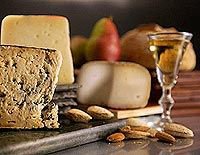
Falling for amontillado
Amontillado is the older sister of fino sherry. Amber-colored and smelling of nuts, caramel and spice, this sherry seems made for the "brown spices" of fall: cinnamon, allspice and nutmeg. Although dark in color, amontillado should be treated much like a white wine and will match up well with many of autumn�s savory dishes. FULL ARTICLE �
Click here: Newsday.com: Falling for amontillado
http://www.newsday.com/features/food/foodanddrink/sns-fddrink1-wk3,0,2255126.story
Food
--------------------------------------------------------------------------------
From the Chicago Tribune
DRINK FEATURES
Falling for amontillado
This amber-colored sherry mimics the warm spices of autumn
Photo

Enjoy amontillado as an
aperitif or with a fall
favorite: butternut squash
soup (Photo by Bob Fila)
By Bill Daley
Chicago Tribune Food and Wine Reporter
Perhaps it is because I first learned about amontillado sherry in the dinner scene from the movie "Babette's Feast," but I've always thought of it as a food wine. You might want to do the same, especially now in the fall and winter months.
Amontillado (Ah-MOHN-tee-YAH-doe) is the older sister of fino sherry. Amber-colored and smelling of nuts, caramel and spice, this sherry is made for the "brown spices" of fall, cinnamon, allspice, nutmeg and clove, said Todd Hess, wine director of Sam's Wines & Spirits in Chicago, who believes that amontillado serves as a bridge between the sparkling wine or crisp white wine served with hors d'oeuvres and the red wine of the main entree.
"Rich, nutty, full-flavored soups are a great match," he said. Indeed, in "Babette's Feast" the amontillado was served with the turtle soup.
Although dark in color, amontillado should be treated much like a white wine, according to Tracy Lewis Liang, director of wine and spirits at Chicago's Treasure Island Foods. Like Hess, she thinks amontillado belongs at-table.
"A glass of amontillado is not only a great winter aperitif but also a fantastic match with roasted chicken, roasted butternut squash or a mushroom risotto," she said.
Doug Jeffirs, director of wine sales for Binny's Beverage Depot stores in metropolitan Chicago, suggested pairing amontillado with a crackling fire, an assortment of nuts, especially walnuts and pecans, and rich veined cheeses.
"They echo the richness of the cheeses and rich, earthy flavors of the nuts in a way that makes you stop in your tracks," he said.
Like all sherries, amontillado is a fortified wine. That means brandy or some neutral spirit has been added to raise the alcohol level and give the sherry more oomph.
Amontillado is essentially created by age and air. It starts with fino sherry, the youngest, lightest and driest of the sherries. Fino gets its distinctive flavor and aroma from flor, a cap of yeast that keeps oxygen away from the wine. The flor can live for up to eight years. When the flor dies, or if it is never introduced in the first place, air reaches the sherry and oxidizes it, darkening and giving the sherry a nuttier flavor.
According to The Sotheby's Wine Encyclopedia, a fino sherry that starts to darken in the cask is called a fino-amontillado. It is considered a full amontillado after eight years, when it acquires the nutty character and more body. The alcohol content will be about 16 to 18 percent.
Sterling Pratt of Schaefer's in Skokie, Ill. urges wine lovers to have fun with amontillado, feeling that the drink is stuck as "a 19th-Century beverage with a weak grasp on 21st-Century drinkers." Partially to blame, he said, is Edgar Allen Poe and his tale of murderous revenge, "The Cask of Amontillado."
"We are far removed from the culture that gave us Poe's vision of amontillado," Pratt said. "The image of old, dank cellars with rows and rows of racks full of dusty bottles has little to do with the 21st Century."
Interestingly, Jeffirs reported that chardonnay drinkers seem to have the easiest time turning to amontillado.
"Maybe it is less of a stretch in terms of the flavor profiles," he theorized, adding that everyone needs to try an amontillado at least once in their lifetime.
A hint of the sea
Perhaps it's the location of the Jerez sherry region on Spain's Andalusian coast that gives a certain maritime saltiness to this fortified wine. This flight of amontillado sherries had a brininess that surprised some sippers on the Good Eating tasting panel.
These amontillados shared a gorgeous amber color that ranged from a honeyed gold to an almost smoky orange. And the aromas! Notes of raisins, nuts, vanilla and, quite possibly, a whiff of the sea.
Hartley & Gibson's Imported Amontillado Jerez de la Frontera
Light nutty notes offset the dark caramel color. The taste, more fino in style, has minerality that verges, pleasantly, on oiliness. Good toasty spice notes. Not as salty as some other amontillados sampled. $9
Bodegas Pedro Romero Amontillado Medium Dry
A very smooth sherry, with an earthy smoothness underlying the raisin-ey, peppery flavor. The taste is less intense than the aroma, which is slightly medicinal and reminiscent of saffron. $10
Bodegas Dios Baco Amontillado
This sherry has a spicy creaminess that recalls spiked eggnog. Long, long finish, nutty with a nice hazelnut scent. $17
Hidalgo Amontillado Napoleon Sanlucar de Barrameda
Soft, woody and emphatically salty, not surprising given Sanlucar de Barrameda's seaside location, with a smell akin to cedar and eucalyptus. $17
Lustau Amontillado Solera Gran Reserva San Bartolome
Notes of grilled pineapple, caramel and nuts intrigued the nose, but the amontillado was too salty for some tasters. $20
Lustau Amontillado Solera Reserva Los Arcos
Way too salty for most panelists. $11
Sources: Not every wine may be in stock at your local stores; prices may vary from store to store. Prices are rounded off.



No comments:
Post a Comment